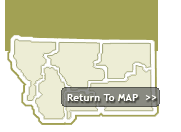

| Home | Communities | Accommodations | Places To Go | Things To Do | Site Map |
|
Glacier Country
Central Montana
Missouri River Country
Southwest Montana
Yellowstone Country
Southeast Montana
|

Kootenai FallsLibby MontanaListing Type: LandmarkCity: Libby Montana Region: Glacier Country 406-752-5501 http://fwp.state.mt.us |  More Images |
Kootenai Falls is the largest undammed falls in the state and a major attraction to those traveling through the area. It offers an unforgettable and breathtaking view as the Kootenai River loses 300 feet in elevation traveling a few hundred yards down river. A pleasant surprise to any photographer or nature lover. An attraction at the falls is a swinging bridge that provides access to the opposite side of the Kootenai River, a prime Montana fishery. To the Kootenai tribe, the falls is a sacred site. They view it as the center of the world, a place where tribal members can commune with the spiritual forces that give direction to the tribe and to individual members. Archaeological evidence shows the Kootenai had Native American sweat lodges and encampments up and down he river valley from Pipe Creek, (where light clay was found for pipes) to the falls area.
Management goal: To provide year-long habitat for bighorn sheep and seasonal habitat for whitetail deer, mule deer, and black bear.
Hunting opportunities: Bighorn sheep hunting by permit only. Archery and rifle hunting seasons for mule deer, white-tailed deer, and black bear, as well as upland game bird and waterfowl hunting, are open to licensed hunters.
Fishing opportunities: The Wildlife Management Area provides walk in fishing opportunities along three miles of the Kootenai River.
Wildlife viewing: Bighorn sheep, white-tailed deer, and mule deer may be seen on the Wildlife Management Area during any time of year, but are most observable from fall through spring. Black bears are regular fall visitors. Moose and elk are seen occasionally, while bobcats and mountain lions are often present but seldom viewed. Bald eagles are in the vicinity of the Wildlife Management Area throughout the year, while ospreys are common during spring and summer. Shorebirds, waterfowl and a host of songbirds can be seen along the river during much of the year.
Directions: Kootenai Falls is located Lincoln County in northwestern Montana, 7 miles northwest of Libby. Take Montana Highway 37 north from Libby to Kootenai River Road (county road).
Kootenai Falls
Montana Department of Fish Wildlife and Parks, Kalispell, MT 59901
|
A source for Montana Travel & Tourism Information
![]()